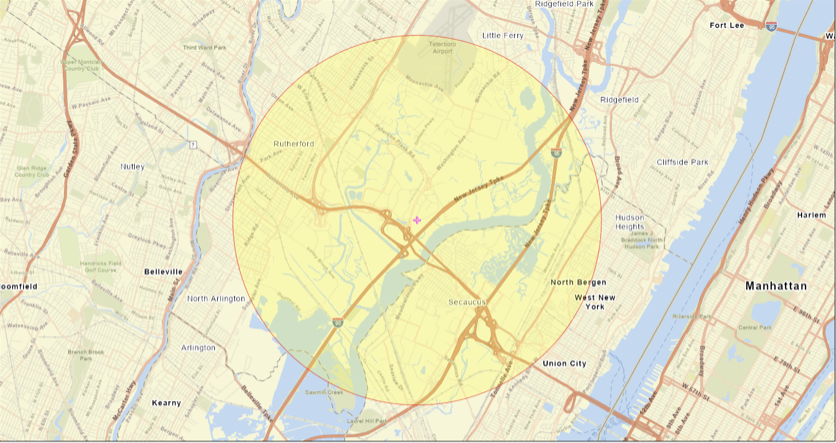American Dream Mall: Bergen County’s Future Environmental Injustice Nightmare
by Alexandra Vidal
Site Description:
After almost 20 years after its inception, in October 2020 the American Dream Mall, the second-largest shopping center in the United States, finally opened its doors. American Dream is located on top of the meadowlands of Bergen County, New Jersey which has been historically polluted by industry and still has not been fully cleaned. The mall will be responsible for an increased amount of air pollution, all to provide tourists and wealthy people with another retail destination while risking the health and environment of the working class, minority populations in the area. This paper argues that this site should be considered environmental justice issue and that it is also exclusionary of working class people that live in the area.
The historical questions that the project would explore are: To what extent are working class, local residents excluded from partaking in this mall? Additionally, how do environmentalists overlook the potential environmental justice elements when critiquing American Dream?
Final Report:
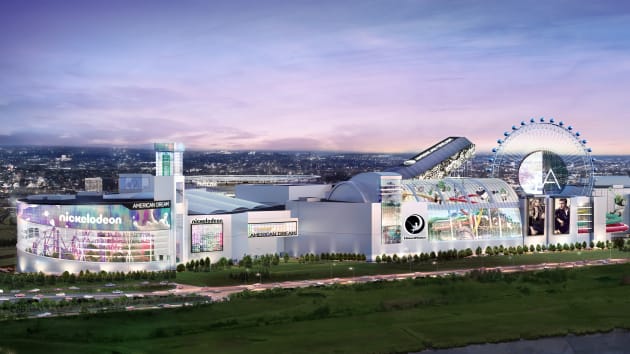
The American Dream Mall was created with the intent to capture the hearts and minds of America, and largely the world, but it was at one point referred to as the “ugliest damn building in New Jersey, and possibly America” by the former New Jersey Governor Chris Christie.1 To be fair, American Dream, previously known as Xanadu, was once a ghastly structure. Its exterior was marred by terribly contrasting colors, ranging from light baby blues and grays to dingy brown and orange hues (see image on left below). Its infrastructure wasn’t any better, it was eclectic and confusing leaving the mall with no discernible shape or structure. As can be seen from the image below on the right, American Dream has come a long way since Christie’s critique and that’s in part because of his support.
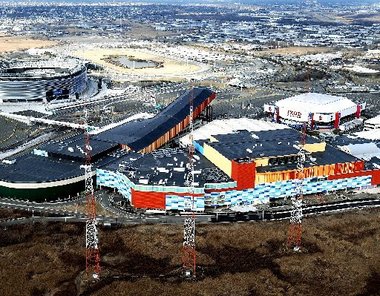

Despite his disparaging comments about American Dream, Christie provided more state aid to get the construction finished because he believed the mall would be a “great idea for New Jersey.” 2 At first glance it can be assumed that the great part about American Dream would be it bringing in state revenue by way of taxes, which in other interviews he would say it is. 3 However, in this particular interview that he had with investigative reporter Robert Hennelly, Christie made it a point to stress how one of the primary goals was to have American Dream done in time for the 2014 Super Bowl.4 Having this mall done during such a highly televised event would, presumably, allow the country to see a more luxurious and exciting New Jersey. By this thought process it can be concluded that by American Dream’s revitalization the state of New Jersey was rebranding itself. To an extent, this would prove successful, but at what cost?
Environmentalist groups, such as the Sierra Club, would say at too high a cost considering that American Dream resides on top of the Hackensack Meadowlands. Much of the pushback from the Sierra Club has been about the negative effects the mall will have on the environment.5 To understand this critique on the mall, first it has to be understood what the Meadowlands are and their importance. The Meadowlands are located across Northern New Jersey and are made up of mostly waterways and wetlands, where the natural habitat is just starting to recuperate after decades of dumping of chemicals, unregulated landfills, and environmental degradation caused by real estate developments such as this mall.6 This makes the Meadowlands a highly sensitive site, which has led the Sierra Club to critique American Dream for endangering this recovery process. This critique on the mall is completely valid and warranted, and yet much like Christie’s perspective this critique comes off as tone deaf.
Both Christie’s praise and Sierra Clubs critique of American Dream are tone deaf because neither attempts to incorporate the local people or analyze how they will be affected, which raises many questions. Firstly, to what extent are working class, local residents excluded from partaking in this mall? Secondly, how do environmentalists overlook the potential environmental justice elements when critiquing American Dream? This paper seeks to answer these questions by analyzing the ways in which the local people in the Meadowlands are largely ignored by the existing discourse surrounding the mall. The people of the Meadowlands are not prioritized by those who want the mall for tourism purposes and their wellbeing is not prioritized by those that oppose the mall for environmental concerns.
Currently, the existing literature written about American Dream has been produced by journalists throughout New Jersey touching on some of the many issues the mall has faced. One of the most instrumental articles for this project is “Chris Christie’s Era of Misrule in Jersey: The Empty Swamp Mall and the Canceled Tunnel” written by Robert Hennelly and published in Salon.com. This article is able to consolidate much of the background information on the mall’s twenty year history and analyses the intense struggle over the development of the Meadowlands between the Sierra Club and the New Jersey Sports and Exposition Authority (NJSEA), which is the government agency that owns the land American Dream is on.7 Another important article written about American Dream is titled “Huge Mall Rising at Troubled Site in North Jersey” by Charles V. Bagli. This article brings in the perspective of the American Dream’s developers and their goals for what the mall will become.8 This will prove important when analyzing the type of people or consumers this mall was built for . Although these articles are both important to this project they are representative of a larger problem in the existing literature about American Dream, which is the lack of analysis through the framework of environmental justice on how the people that live around the mall will be affected by it.
The lack of scholarly literature on American Dream, and the Meadowlands at large, create a large gap in the historiography of this topic which this project will attempt to address. I was able to find one dissertation by Dawn Robert-Semple’s titled “Air pollution, meteorology and public health in New Jersey” that touched on the environmental impacts of automobiles and industry in the Meadowlands. Although this dissertation has served as an asset to this project, it does not go far enough into analyzing the Meadowlands as an environmental justice site or even at the roles race and class may play into that.
In order to be able to fill this gap, I will be relying on the findings of my own research to see if there’s enough evidence for an environmental justice claim to be made against American Dream. I will do this primarily by using statistical information about the demographic indicators and environmental hazards currently affecting the Meadowlands. The majority of this information was gathered by using the Environmental Protection Agency’s (EPA) Environmental Justice Mapping Tool. To guide my analysis of this data I will also be relying on the frameworks of environmental justice written in From the Ground Up : Environmental Racism and the Rise of the Environmental Justice Movement by Luke Cole and Sheila R. Foster. This book will work as a guideline to link the demographic and environmental indicators of the site to the larger ideas of environmental injustice in the section section.
Since this project seeks to analyze two different components of the American Dream Mall, it will be divided into two sections. The first section of this paper will give background information on the mall. It is also dedicated to analyzing what groups are excluded from partaking in this mall through the accessibility of public transport. Additionally, the second point that will be analyzed is whether the local people in the Meadowlands are able to partake in the mall in the same ways as wealthier, suburbanites or even tourists can. The second section of the paper will focus on the criticism levied by the Sierra Club against American Dream. This part of the paper will analyze how the Sierra Club does not acknowledge environmental justice elements when discussing the negative effects of the American Dream Site. Similarly, whether an environmental justice claim can be made will be analyzed through a data analysis included in this section of the project.
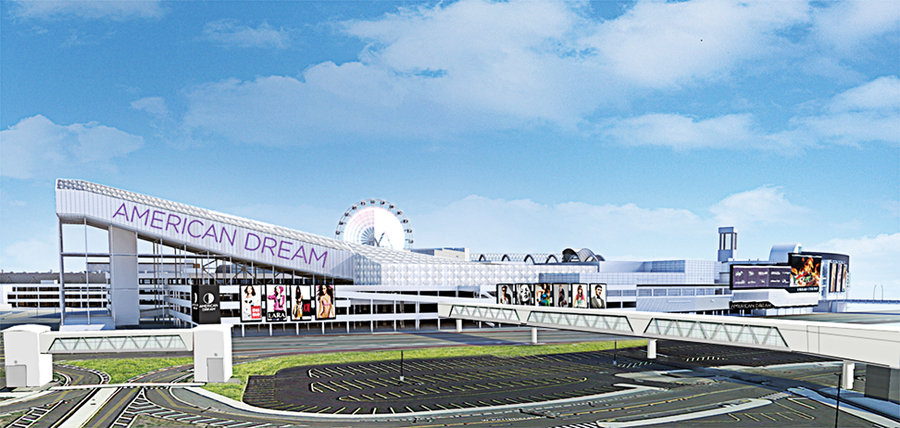
American Dream Mall: Whose Dream Is It Anyway?
Twenty years ago, American Dream was nothing more than just an idea and in the journey of that idea becoming a reality it has had some drastic changes from its original form. The road to getting the American Dream Mall we know today was a long and arduous one. So long in fact that by the time the mall finally opened its doors to the public in October 2020, it had gone through four governors, three real estate developers, three name changes, and several lawsuits.9 One of the most influential arose from the time period in which the mall is opening. Since it is being opened during the retail apocalypse, where by 2022 twenty five percent of malls are expected to close, American Dream had to change its approach in how it was marketed.10 The mall would have to provide consumers with more than just a shopping mall experience.
American Dream’s developer, Triple Five, has attempted to guarantee this by having the majority of the amenities in the mall be centered around entertainment. Claire Lampen’s article “Inside American Dream, The Mega-Mall New Jersey Maybe Didn’t Need” goes into more detail about the things inside this Goliath of a mall. More specifically, the mall houses an indoor amusement park, indoor waterpark, ice rink, “an aviary; a 16-story ski slope; a “live bunny field”; concert venues; mini golf; Legoland; an aquarium; a luxury movie theater”, hundreds of stores and restaurants, and so much more.11 It takes a lot of space to fit all of these amenities, luckily the mall sits on three million square feet of state owned land leased to them by the New Jersey Sports and Exposition Authority (NJSEA).12 All of these amenities and luxurious tourist traps are part of New Jersey’s larger goal of revitalizing and rebranding this Meadowlands region.
This is most clear when analyzing the reasons for which New Jersey state officials, most notably Chris Christie, wanted American Dream built in the first place. As mentioned in the introduction, Christie wanted to show off a completed American Dream in time for the Super Bowl.13 The real goal behind this was to retain two major sports teams, the Devils and the Nets.14 This coupled with the MetLife Stadium in the Meadowlands Sport Complex would have had the ability to completely change New Jersey’s reputation from the land of the smelly swamps or even as the armpit of America into a renowned tourist Mecca.15 This venture to reclaim the Meadowlands has been a long time coming, even before Christie’s involvement. Throughout all of these plans to redevelop the Meadowlands into a highly visited place, the need for dire public transportation reform to get to the American Dream Mall has also been widely known.
From the time that former governor Jim McGreevy was eyeing the development in this area of the Meadowlands, it was known that public transportation changes would have to be made. This can be seen in an archived article from 2003 by Jack Lyne called “$1.3B, 4.8MSF Xanadu Project Will Transform ‘Swamps of Jersey’.” Here McGreevy touts what an excellent opportunity it would be to build this mall on the Meadowlands Sports Complex, while cautioning to one thing that may deter the mall’s success: A lack of access to transportation. 16 Despite this forewarning the issues concerning public transportation were not resolved until this last year in 2019. This further shows how the mall itself isn’t meant for working class people in the area, but rather for the tourists and our wealthy counterparts across the Hudson River.
Before there was ever a plan put in place to ensure public transportation to American Dream, the mall already had plans to create parking spots for helicopters. This alone shows that the priorities are not the working class people for the developers of the mall. This is seen most clearly in Lisa Fickenscher’s article “Long-Delayed NJ Mall Featuring Helicopter Transport from NYC Seeking Luxury Tenants.” Fickenscher writes that American Dream is launching a helicopter service “to bring wealthy international tourists and Manhattanites to the complex.”17 The reason why these helicopters are needed, you ask? The article states that American Dream “is just five miles away from Times Square but hours’ worth of traffic away on a busy weekend.”18 In other words, the traffic issues caused by American Dream are acceptable for working class people, but not for the elite in New York and in the Hamptons.19 This is exemplary of how this mall is not for the people of the Meadowlands, but rather for the enjoyment of rich tourists and New Yorkers.
Those that fought for American Dream’s success to redevelop the Meadowlands prioritized the revitalization of the state’s tourism, over the accessibility of the working class people. It is an egregious affront to the people of the Meadowlands, because they are directly excluded from an establishment that is funded primarily by tax dollars.20 More importantly, those elected officials in power did not acknowledge the issues that this mall would bring until the very last second. The truth in the matter is that the people in the Meadowlands were not prioritized throughout the creation of American Dream. This same lack of prioritization of the needs of the local people in the Meadowlands can be seen in the critiques of American Dream given by the Sierra Club.
American Dream: Who Does it Really Affect?
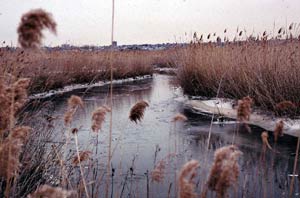

The Sierra Club has been a vocal, long-time adversary of the American Dream Mall, based primarily on the negative effects that the mall will have on the Meadowlands. Sierra Club’s primary grievance against American Dream is the mall’s decision to fill in five more acres of wetlands to build a waterpark.21 The priorities of why they are against the mall can be seen through Sierra Club’s press releases. Jeff Tittel, the director of Sierra’s new Jersey chapter, stressed in a press release that developments like American Dream in “the Meadowlands will not only put more people in danger of flooding but will impact wetlands and the fragile ecosystems.”22 When closely observed it can be seen that the focus on Tittel’s critique in this quote and throughout the statement is not actually on the flooding issues people will have to deal with in the future, it is on the effect on the environment. The environmental impact that humans will have to deal with is secondary to the effects that the ecosystem in the Meadowlands will endure. This is most clear in the next sentence when Tittel goes on to add that the government should focus on “protecting and enhancing the natural habitat”, not developing it further.23 This shows that Sierra’s number one concern with regard to the effects of American Dream is the actual preservation of the Meadowlands, not the well-being of the people surrounding it.
The American Dream Mall can be seen as a compelling case study that shows the rift in priorities held by the frameworks of traditional environmentalism and environmental justice. As it is explained in From the Ground Up by Cole and Foster, environmentalism is environment- centric where the onus is on “the preservation of wildlife and wilderness— concerns that are just not central to the everyday survival of poor communities and communities of color.” 24 Environmentalism, unlike environmental justice, doesn’t explicitly fight for an environment that isn’t negatively affecting the health of the people living in it.25 Its focus is on the maintenance of the ecosystems of that environment and limiting the negative effects caused by humans. 26 This difference in priorities between these two movements is exemplified in the Sierra Club’s plight against American Dream.
This focus on prioritizing the health and safety of the Meadowlands over the people that live around it is clear when looking at the court conclusion of the 2008 lawsuit that the Sierra Club launched against American Dream. 27 In this lawsuit, the Sierra Club brings up several issues that American Dream and NJSEA did not adequately acknowledge, such as how the increase in traffic brought on by the mall may worsen air quality.28 These concerns may seem like they are addressing possible health issues brought on by air pollutants, but this is proved incorrect later on in the court document. In the concluding remarks of the Superior Court of New Jersey with regards to this case, it was noted how “the statute against which any opinion is to be measured concerning the environment, is focused solely on assuring that the delicate environmental balance of the Hackensack Meadowlands is maintained and preserved.”29 This excerpt highlights how the Meadowlands well-being is the primary concern of Sierra Club’s lawsuit, but it is also prioritized in the legal framework.30 Even when discussing traffic and air quality, for the Sierra Club how American Dream’s pollution would affect the Meadowlands takes precedence over how it would affect the humans breathing in these toxic fumes. To understand how American Dream may impact air pollution in the Meadowlands, its effect on traffic has to be understood.


American Dream’s highly visible location in the Meadowlands Sports Complex is one of the reasons that made the mall look like a success in theory. The Meadowlands Sports Complex is just five miles West of Manhattan and is directly across three major state highways namely, the New Jersey Turnpike, Route 3, and Route 120.31 This would make it an ideal location for commuters or even New York tourists to stop in due to it’s availability and visibility in all three highways. As a matter of fact, nearly 40 million people annually are expected to visit this mall once it is fully open to the public. This type of exposure would seemingly make the mall highly profitable and in many ways a landmark in New Jersey, that’s if anyone is able to actually get to the mall.
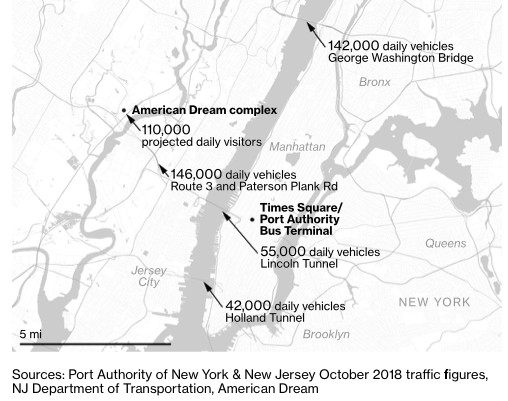
American Dream is set to affect the highway lanes and air pollution of the Meadowlands permanently. As aforementioned, the mall is expecting to have forty million visitors annually, which makes it roughly 110,000 daily visitors. 32 Although there is some access to public transportation, there is no telling whether tourists or people across the metropolitan area will actually use it. Even half of these 110,000 additional people on New Jersey highways would still be widely regarded as a traffic nightmare.33 As it can be seen from the figure above, the mall’s 110,000 expected daily consumers will further aggravate highways that are already challenged with just 150,000 daily drivers.34 This influx of cars would exponentially increase automobile emissions to the area, undoubtedly affecting the environment but the health of the people living in it too. The effect on the people surrounding the Meadowlands has to be a part of the conversation when critiquing American Dream’s future effects. By focusing solely on the effects on the environment the Sierra Club is effectively ignoring an existing public health issue faced by the Meadowlands.
The air pollution and the health hazards faced in the Meadowlands have not been studied appropriately and so this public health issue in the Meadowlands has been left largely ignored. 35 Through my research the only scholarly literature I was able to find about the disparate air pollution impacts in the Meadowlands was a 2008 dissertation by Dawn Robert-Semple’s titled “Air pollution, meteorology and public health in New Jersey”. In this dissertation Robert- Semple was able to provide a thorough data analysis on the pollutants that plague the Meadowlands and the ways in which they affect public health.36 Here a link between harmful pollutants and respiratory health effects were observed in the Meadowlands.37 Robert-Semple’s findings can be seen as a forewarning about American Dream of sorts, where air pollutants “may intensify as cities continue to expand and an over-dependence on motor vehicular transport becomes likely.”38 This is what may happen in the Meadowlands due to developments that require individual vehicle use as a means of transportation, such as American Dream. Although, Robert-Semple’s dissertation proves to be valuable in the conversation surrounding the Meadowlands it still has its faults, in that it does not factor in the extent to which environmental injustice may be taking place here.
Health Impact on Meadowland Locals
This section of the project will go through a data analysis of environmental and demographic indicators in the Meadowlands to understand whether an environmental injustice is occurring in this site. The tools used for this analysis were provided by the EPA’s Environmental Justice Screening and Mapping Tool. The pinpointed location in the figure above is American Dream with a three mile buffer around it. The buffer was chosen to cover three miles to capture data of the areas in the Meadowland that will surround the mall. Included within this buffer is an estimated population of 104,832 people. The environmental indicators chosen for this analysis were National-Scale Air Toxics Assessment (NATA) Diesel Particulate Matter (PM), NATA Cancer Risk, NATA Respiratory Hazard Index (HI), and Traffic Proximity. The demographic indicators chosen are Minority Population, Low Income Population, Linguistically Isolated, and less than High School education. Each category will be compared by state and national outcomes and described in percentiles. Percentiles describe what percent of the state or national population “has an equal or lower value, meaning less potential for exposure/ risk/ proximity” to each category.39 This data will be analyzed with the understanding of how environmental justice can affect communities by class or race to see if a conclusion can be made on whether an environmental justice issue is occurring here.
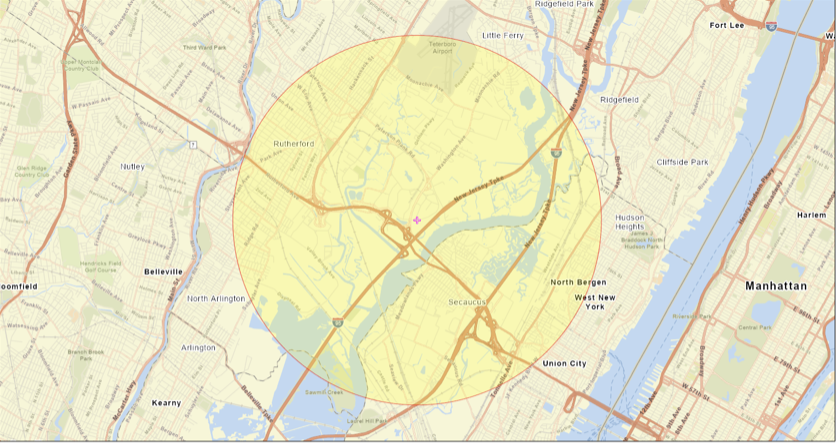
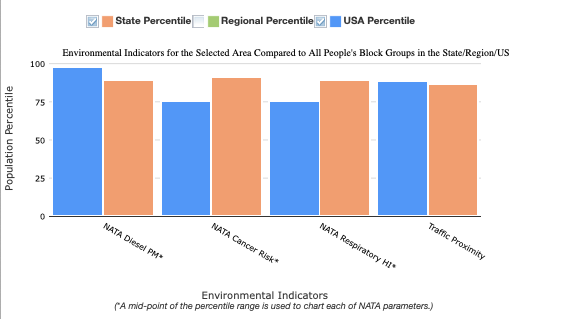
Upon examining the environmental indicators in this map it is clear that there is an air pollution issue that is affecting the health of the people that live here. In the NATA Diesel PM category, which calculates how much diesel particulate matter there is in the air, this area ranks 89th percentile in the state and 95-100th percentile in the country.40 A possible explanation for such a high ranking can be found when observing the traffic proximity on the chart, which shows that this area on the map is 86th percentile in the state and 88th percentile in the country. Clearly, air pollution is an issue here and is caused by this traffic, making it land on one of the highest percentiles for both of these categories. This does not take into account any additional traffic that may be caused now or in the future by American Dream, this is already a burden that is affecting this area that will be worsened by adding 100,000 more cars onto the road.
In this same chart, health effects that can be attributed to NATA Diesel PM and traffic proximity can be seen. Specifically, in NATA Cancer Risk and NATA Respiratory Hazard Index. The NATA cancer risk shows the “lifetime cancer risk from inhalation of air toxics” and the population in the map fell in the 91st percentile in the state and 70-80th percentile in the country.41 Similarly, for the NATA Respiratory Hazard Index which is the “ratio of exposure concentration to health-based reference concentration” this population came out to be 89th percentile and 70-80th percentile.42 This finding shows how there is a correlation between the traffic, the PM released by the cars in that traffic, and the deteriorating health of the people on this map. Now let’s get to see some information about the people in the Meadowlands.
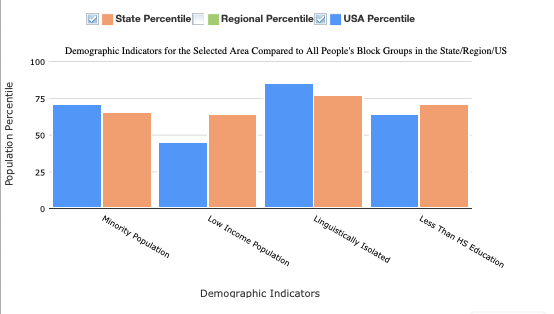
The demographic indicators in this map are able to tell us about the people that reside here and whether they may have any characteristics or challenges that may make them susceptible to environmental injustice. The first indicator is understanding the percentage of the minority population, here 56% of the population is minority and it ranks 65th percentile and 71st percentile in the country. The population isn’t overwhelmingly minority, but the percentage is relatively high when compared to areas of the rest of the state. The next indicator is the low- income population, which makes up 27% of the population on this map ranking 64th in the state and 45th percentile in the country. This means that almost 1 in 5 people included in this map are low income, and much like the minority category compared to the state it is a high number. The fact that the communities surrounding American Dream are composed of working class, ethnic minorities go in line with the environmental justice theory of race and class being indicators for toxic waste sites.43 These two pieces of data are incredibly important through the lens of environmental justice because they coincide with the theory that class and race are the two most working class, people of color.44 This is also true for the last two indicators observed for this site.
The two final indicators observed in the environmental justice analysis of the American Dream site are linguistically isolated and education level indicators. According to EJScreen, the linguistically isolated population in this area, which either don’t speak English or don’t speak it very well, makes up 11% of the total population.45 This high percentage means that this indicator ranks in the 77th percentile in the state and 85th percentile in the country and is the highest overall when compared to the state and country percentiles. This is an important factor when discussing environmental justice because a linguistically isolated population may not be able to advocate for themselves or keep themselves informed in the same way english speakers can.46 The last indicator is the population that has less than a high school education, and roughly 14% of the total population falls in this category making it 71st percentile in the state and 64th in the country. This is another high percentage and high percentile result that is valuable in the environmental justice discourse of this site because the lower education level also tends to point to a working class background. Both of these factors tend to correlate with a toxic site in the area.47
Both the environmental and demographic data is alarming in nature, because of all of the health risks and environmental hazards are currently present without even taking into account the pollution that will be brought on by American Dream. Moreover, understanding it is still important because it showcases the ways in which this community is affected by environmental hazards, and it begins to tell a story as to why these issues are occurring. Each environmental indicator came out in an extremely high percentile and it shows that the pollutants in this area have a hand in or are causing the health hazards. This is important to emphasize because the current environmental and health issues have not even been exacerbated yet by the traffic and pollution that American Dream will cause.
This is important when looking at the demographic indicators under the lens of environmental justice, because there is a link between minority, working class communities “with weak social, economic, and political capital” and the amount of environmental hazards in their communities.48 This can be considered to be true in the case of this site where a large portion of the population is minority and low income, but more telling is that 10% of the population is linguistically isolated. All of the results from these demographic and environmental indicators of this site go hand in hand with the theory of the path of least resistance. This theory argues that industries would purposely go to communities of color, that were low income, or even had low educational levels because they would not be able to fight back like other communities that were white, wealthy, and well-connected.49 This specific indicator is a good example of that, because this large portion of the population may not be able to advocate for themselves or does not have the same sort of social or political capital to enact change as easily as everyone else.Although this is an issue that is true for most sites that deal with environmental injustices, it cannot be said with certainty that this is true for Meadowlands.
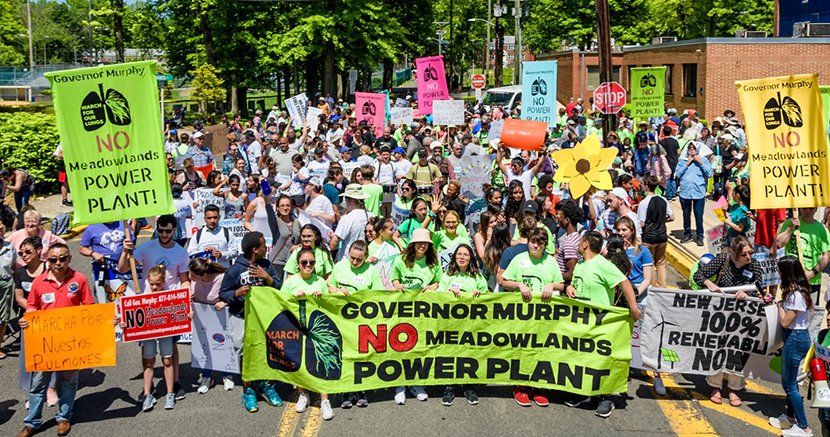
The people of the Meadowlands have stood up against environmental injustices in the past, most notably when a giant power plant was set to be built in North Bergen.50 Students organized against this with a clear understanding that the power plant wasn’t being placed in their communities out of sheer luck, it had all to do with the demographic makeup of the Meadowlands. The people and, more specifically, the youth in the Meadowlands is educated and knowledgeable about how their community is more susceptible to environmental injustices.51 Although it is too late to stop the creation of American Dream, it does not make it unnecessary to analyze it as an environmental justice site.
I write all of this to say, that just because the American Dream is not going to directly and visibly pollute the air it does not make its effects any better. Yes, the mall is already built, but it does not mean that the people of the Meadowlands are powerless to lessen this injustice. They can organize and ask for accountability for government officials at the local and state level that allowed it to happen. They can organize to create a scientific record of the ways in which air pollution and greenhouse emissions were worsened by the mall. The people of the Meadowlands can even use this as a teachable moment and organize to get zoning laws changed or even strip NJSEA of its total control over the Meadowlands and the Sports Complex.52 The people of the Meadowlands will have to organize and take back ownership over their community’s destiny because those in power are not likely to giving it up willingly.53
Bibliography
“The Hackensack Meadowlands in the Imagery: History of a Deep Social and Environmental Transformation.” City in Environment. http://cityinenvironment.blogspot.com/2013/03/ the-hackensack-meadowlands-in-imagery.html.
“How to Interpret a Standard Report in EJSCREEN.” EPA. Environmental Protection Agency, December 19, 2016. https://www.epa.gov/ejscreen/how-interpret-standard-report- ejscreen.
“Overview of Demographic Indicators in EJSCREEN.” EPA. Environmental Protection Agency, September 14, 2020. https://www.epa.gov/ejscreen/overview-demographic-indicators- ejscreen.
“Overview of Environmental Indicators in EJSCREEN.” EPA. Environmental Protection Agency, December 2, 2019. https://www.epa.gov/ejscreen/overview-environmental- indicators-ejscreen.
Bagli, Charles V. “Huge Mall Rising at Troubled Site in North Jersey.” The New York Times. The New York Times, October 2, 2015. https://www.nytimes.com/2015/10/03/nyregion/ dream-of-a-mall-starts-to-rise-out-of-a-meadowlands-nightmare.html?_r=0.
Bhattarai, Abha. “Malls Are Dying. The Thriving Ones Are Spending Millions to Reinvent Themselves.” The Washington Post. WP Company, November 25, 2019. https:// http://www.washingtonpost.com/business/2019/11/22/malls-are-dying-only-these-ones-have- figured-out-secrets-success-internet-age/.
Bullard, Robert D. “Chapter 2- Race, Class, and the Politics of Place.” In Dumping in Dixie: Race, Class and Environmental Quality. London: Routledge, E-book, 2019.
Brennan, John. “Xanadu Overview.” Assorted press releases — October 12, 2004. http:// http://www.rst2.org/njheps/meadowlandsquest/teterboro/pr1.html.
Coen, Andrew. “New Jersey’s American Dream Project Brings Big Claims from Governor,” August 24, 2017. https://www.bondbuyer.com/news/new-jerseys-american-dream- project-brings-big-claims-from-governor.
Cole, L., & Foster, S. (2001). From the Ground Up : Environmental Racism and the Rise of the Environmental Justice Movement . New York University Press,. https://doi.org/ 10.18574/9780814772294
Fallon, Scott. “From Dumps to Doves, How Cleanup Efforts Transformed the Meadowlands into a Bird Sanctuary.” North Jersey Media Group. NorthJersey, September 13, 2018. https://
http://www.northjersey.com/story/news/environment/2018/09/12/meadowlands-now-haven- birds-according-audubon/1123676002/.
Fickenscher, Lisa. “Long-Delayed NJ Mall Featuring Helicopter Transport from NYC Seeking Luxury Tenants.” New York Post. New York Post, April 9, 2019. https://nypost.com/ 2019/04/07/long-delayed-nj-mall-featuring-helicopter-transport-from-nyc-seeking- luxury-tenants/.
Hennelly, Robert. “Chris Christie’s Era of Misrule in Jersey: The Empty Swamp Mall and the Canceled Tunnel.” Salon. Salon.com, July 18, 2017. https://www.salon.com/ 2017/07/17/chris-christies-era-of-misrule-in-jersey-the-empty-swamp-mall-and-the- canceled-tunnel/.
IN THE MATTER OF THE PROPOSED XANADU REDEVELOPMENT PROJECT AND THE APPROVAL OF THE JOINT HEARING OFFICERS’ REPORT BY THE NEW JERSEY MEADOWLANDS COMMISSION AND THE NEW JERSEY DEPARTMENT OF ENVIRONMENTAL PROTECTION PURSUANT TO N.J.S.A. 5:10-23 AND OF THE SECTION 5(X) CONSULTATION REPORT BY THE NEW JERSEY MEADOWLANDS COMMISSION PUR- SUANT TO N.J.S.A. 5:10-5(X) WITH RESPECT TO THE PRO- POSED PROJECT. (https://cite.case.law/pdf/3788159/ In%20re%20the%20Proposed%20Xanadu%20Redevelopment%20Project, %20402%20N.J.%20Super.%20607,%20955%20A.2d%20976%20(2008).pdf September 17, 2008).
Lampen, Claire. “Inside American Dream, The Mega-Mall New Jersey Maybe Didn’t Need.” Gothamist. Gothamist, November 5, 2019. https://gothamist.com/arts-entertainment/ inside-american-dream-mega-mall-new-jersey.
Lynch, Rene. “Dove Kills Ad Calling New Jersey ‘the Armpit of America’.” Los Angeles Times. Los Angeles Times, March 4, 2014. https://www.latimes.com/nation/la-sh-dove-kills-ad- calling-new-jersey-the-armpit-of-america-20140304-story.html.
Lynne, Jack. “$1.3B, 4.8MSF Xanadu Project Will Transform ‘Swamps of Jersey’, Site Selection Online Insider.” Site Selection Online Insider, August 3, 2003. https://web.archive.org/ web/20060314180611/http://www.conway.com/ssinsider/snapshot/sf030804.htm.
McCormack, Josh. “Environmental Racism Causes People of Color to Face Compound Exposures.” Salud America, June 16, 2020. https://salud-america.org/environmental- racism-causes-people-of-color-to-face-compound-exposures/.
Marritz, Ilya, and John Reitmeyer. “Who Benefits Most from New Jersey’s ‘American Dream’ Mega-Mall Project?” WHYY. WHYY, December 16, 2016. https://whyy.org/articles/ who-benefits-from-the-american-dream/.
Marshall, Stephen. “The Meadowlands Before the Commission: Three Centuries of Human Use and Alteration of the Newark and Hackensack Meadows.” Urban Habitats, December 1, 2004. http://urbanhabitats.org/v02n01/3centuries_full.html.
Millsaps, Kate. “American Dream Mall Hurts Environment,” February 16, 2018. https:// http://www.sierraclub.org/new-jersey/press-releases/0341.
Pries, Allison, and Aristide Economopoulos. “Waterslides Are Being Installed at the American Dream Mega-Mall and It Is Glorious.” NJ.com. NJ.com, December 2, 2018. https:// web.archive.org/web/20190819055009/https://expo.nj.com/news/ erry-2018/12/8df3facb447815/waterslides-are-being-installe.html.
Roberts-Semple, Dawn. “Air pollution, meteorology and public health in New Jersey.” Retrieved from https://doi.org/doi:10.7282/T37H1HJ6
Schelly, David, and Paul B. Stretesky (2009). “An Analysis of the ‘Path of Least Resistance’ Argument in Three Environmental Justice Success Cases.” Society & Natural Resources 22 (4): 369–80. https://doi.org/10.1080/08941920802119648.
Taylor, D. (2002). Race, class, gender, and American environmentalism. U.S. Dept. of Agriculture, Forest Service, Pacific Northwest Station.
Thomas, Lauren. “More than 17 Years in the Making, American Dream Megamall’s Story Was Shaped by Retail’s Upheaval.” CNBC. CNBC, October 22, 2019. https://www.cnbc.com/ 2019/10/22/timeline-of-new-jerseys-american-dream-megamall-and-how-it-got- built.html.
Tittel, Jeff. “American Dream Mall Hurts Environment.” Sierra Club, February 16, 2018. https:// http://www.sierraclub.org/new-jersey/press-releases/0341.
Tittel, Jeff. “Sierra Club: Meadowlands Massive Power Plant: Murphy Must Reject.” Insider NJ, April 11, 2018. https://www.insidernj.com/press-release/sierra-club-meadowlands- massive-power-plant-murphy-must-reject/.
Tittel, Jeff. “Xanadu Bailout: An Ugly Building Has Turned into Dirty Deal for Taxpayers and the Environment.” Sierra Club, February 16, 2018. https://www.sierraclub.org/new- jersey/press-releases/0226.
Wilson, Colleen. “A Quick Guide: How to Get to the American Dream Mega-Mall.” North Jersey Media Group. NorthJersey.com, October 24, 2019. https://www.northjersey.com/ story/news/transportation/2019/10/24/quick-guide-how-get-american-dream-mega-mall- nj/4067027002/.
Worthington, Cassandra, and Matt Smith. “How Students Led a March to Save the Meadowlands from a Fracked Gas Plant.” Food & Water Watch, June 26, 2019. https://
http://www.foodandwaterwatch.org/news/how-students-led-march-save-meadowlands-fracked- gas-plant.
Young, Elise, and Donald Moore. “New Jersey’s ‘Dream’ Mall: 40 Million People and a Traffic Nightmare.” Bloomberg.com. Bloomberg, September 3, 2019. https:// http://www.bloomberg.com/news/articles/2019-09-03/n-j-s-dream-mall-40-million-people-and- a-traffic-nightmare.
Endnotes
1 Levon Putney, “Christies Promises Makeover For Xanadu Complex, ‘Ugliest Building In NJ’,”.
2 Coen, Andrew. “New Jersey’s American Dream Project Brings Big Claims from Governor,”
3 Coen, Andrew. “New Jersey’s American Dream Project Brings Big Claims from Governor,”
4 Hennelly, Robert. “Chris Christie’s Era of Misrule in Jersey: The Empty Swamp Mall and the Canceled Tunnel.”
5 Tittel, Jeff. “American Dream Mall Hurts Environment.”
6 “The Hackensack Meadowlands in the Imagery: History of a Deep Social and Environmental Transformation.”
7 Hennelly, Robert. “Chris Christie’s Era of Misrule in Jersey: The Empty Swamp Mall and the Canceled Tunnel.”
8 Bagli, Charles V. “Huge Mall Rising at Troubled Site in North Jersey.” 9 Bagli, Charles V. “Huge Mall Rising at Troubled Site in North Jersey.”
10 Bhattarai, Abha. “Malls Are Dying. The Thriving Ones Are Spending Millions to Reinvent Themselves.”
11 Lampen, Claire. “Inside American Dream, The Mega-Mall New Jersey Maybe Didn’t Need.”
12 Pries, Allison, and Aristide Economopoulos. “Waterslides Are Being Installed at the American Dream Mega-Mall and It Is Glorious.”
13 Hennelly, Robert. “Chris Christie’s Era of Misrule in Jersey: The Empty Swamp Mall and the Canceled Tunnel.”
14 Hennelly, Robert. “Chris Christie’s Era of Misrule in Jersey: The Empty Swamp Mall and the Canceled Tunnel.”
15 Lynch, Rene. “Dove Kills Ad Calling New Jersey ‘the Armpit of America’.”
16 Lynne, Jack. “$1.3B, 4.8MSF Xanadu Project Will Transform ‘Swamps of Jersey’, Site Selection Online Insider.”
17 Fickenscher, Lisa. “Long-Delayed NJ Mall Featuring Helicopter Transport from NYC Seeking Luxury Tenants.”
18 Fickenscher, Lisa. “Long-Delayed NJ Mall Featuring Helicopter Transport from NYC Seeking Luxury Tenants.”
19 Fickenscher, Lisa. “Long-Delayed NJ Mall Featuring Helicopter Transport from NYC Seeking Luxury Tenants.”
20 Hennelly, Robert. “Chris Christie’s Era of Misrule in Jersey: The Empty Swamp Mall and the Canceled Tunnel.”
21 Tittel, Jeff. “American Dream Mall Hurts Environment.”
22 Tittel, Jeff. “Sierra Club: Meadowlands Massive Power Plant: Murphy Must Reject.”
23 Tittel, Jeff. “Sierra Club: Meadowlands Massive Power Plant: Murphy Must Reject.”
24 Cole, L., & Foster, S. (2001). From the Ground Up : Environmental Racism and the Rise of the Environmental Justice Movement. Page 16.
25 Cole, L., & Foster, S. (2001). From the Ground Up : Environmental Racism and the Rise of the Environmental Justice Movement. Page 30.
26 Cole, L., & Foster, S. (2001). From the Ground Up : Environmental Racism and the Rise of the Environmental Justice Movement. Page 29.
27 IN THE MATTER OF THE PROPOSED XANADU REDEVELOPMENT PROJECT AND THE APPROVAL OF THE JOINT HEARING OFFICERS’ REPORT BY THE NEW JERSEY MEADOWLANDS COMMISSION AND THE NEW JERSEY DEPARTMENT OF ENVIRONMENTAL PROTECTION PURSUANT TO N.J.S.A. 5:10-23 AND OF THE SECTION 5(X) CONSULTATION REPORT BY THE NEW JERSEY MEADOWLANDS COMMISSION PUR- SUANT TO N.J.S.A. 5:10-5(X) WITH RESPECT TO THE PRO- POSED PROJECT. Page 607.
28 IN THE MATTER OF THE PROPOSED XANADU REDEVELOPMENT PROJECT AND THE APPROVAL OF THE JOINT HEARING OFFICERS’ REPORT BY THE NEW JERSEY MEADOWLANDS COMMISSION AND THE NEW JERSEY DEPARTMENT OF ENVIRONMENTAL PROTECTION PURSUANT TO N.J.S.A. 5:10-23 AND OF THE SECTION 5(X) CONSULTATION REPORT BY THE NEW JERSEY MEADOWLANDS COMMISSION PUR- SUANT TO N.J.S.A. 5:10-5(X) WITH RESPECT TO THE PRO- POSED PROJECT. Page 638.
29 IN THE MATTER OF THE PROPOSED XANADU REDEVELOPMENT PROJECT AND THE APPROVAL OF THE JOINT HEARING OFFICERS’ REPORT BY THE NEW JERSEY MEADOWLANDS COMMISSION AND THE NEW JERSEY DEPARTMENT OF ENVIRONMENTAL PROTECTION PURSUANT TO N.J.S.A. 5:10-23 AND OF THE SECTION 5(X) CONSULTATION REPORT BY THE NEW JERSEY MEADOWLANDS COMMISSION PUR- SUANT TO N.J.S.A. 5:10-5(X) WITH RESPECT TO THE PRO- POSED PROJECT. Page 641.
30 In Cole and Foster’s From the Ground Up : Environmental Racism and the Rise of the Environmental Justice Movement, the ways in which traditional, second-wave environmentalists worked was discussed. Most importantly it is discussed how modern environmentalists use “insider strategy based on litigation, lobbying, and technical evaluation” (29). These tactics were used throughout the 1960s onwards and would allow traditional environmentalists to “write most of the environmental legislation” (29). This method of organizing my environmentalists can explain why the law is written to focus primarily on the environmental effects on the Meadowlands, specifically.
31 Young, Elise, and Donald Moore. “New Jersey’s ‘Dream’ Mall: 40 Million People and a Traffic Nightmare.”
32 Young, Elise, and Donald Moore. “New Jersey’s ‘Dream’ Mall: 40 Million People and a Traffic Nightmare.”
33 Young, Elise, and Donald Moore. “New Jersey’s ‘Dream’ Mall: 40 Million People and a Traffic Nightmare.”
34 Young, Elise, and Donald Moore. “New Jersey’s ‘Dream’ Mall: 40 Million People and a Traffic Nightmare.”
35 Roberts-Semple, Dawn. “Air pollution, meteorology and public health in New Jersey.” Page 36.
36 Roberts-Semple, Dawn. “Air pollution, meteorology and public health in New Jersey.” Page 3.
37 Roberts-Semple, Dawn. “Air pollution, meteorology and public health in New Jersey.” Page 87.
38 Roberts-Semple, Dawn. “Air pollution, meteorology and public health in New Jersey.” Page 87.
39 “How to Interpret a Standard Report in EJSCREEN.” EPA.
40 “Overview of Environmental Indicators in EJSCREEN.” EPA.
41 “Overview of Environmental Indicators in EJSCREEN.” EPA.
42 “Overview of Environmental Indicators in EJSCREEN.” EPA.
43 Cole, L., & Foster, S. (2001). From the Ground Up : Environmental Racism and the Rise of the Environmental Justice Movement. Page 3.
44 Taylor, D. (2002). Race, class, gender, and American environmentalism. 45 “Overview of Demographic Indicators in EJSCREEN.” EPA.
46 McCormack, Josh. “Environmental Racism Causes People of Color to Face Compound Exposures.”
47 Bullard, Robert D. “Chapter 2- Race, Class, and the Politics of Place.”
48 Schelly, David, and Paul B. Stretesky (2009). “An Analysis of the ‘Path of Least Resistance’ Argument in Three Environmental Justice Success Cases.”
49 Schelly, David, and Paul B. Stretesky (2009). “An Analysis of the ‘Path of Least Resistance’ Argument in Three Environmental Justice Success Cases.”
50 Worthington, Cassandra, and Matt Smith. “How Students Led a March to Save the Meadowlands from a Fracked Gas Plant.”
51 Worthington, Cassandra, and Matt Smith. “How Students Led a March to Save the Meadowlands from a Fracked Gas Plant.”
52 Hennelly, Robert. “Chris Christie’s Era of Misrule in Jersey: The Empty Swamp Mall and the Canceled Tunnel.”
53 All ideas included in this paragraph are conclusion I reached from my research.
Primary Sources:
- “Sierra Club: Meadowlands Massive Power Plant: Murphy Must Reject.”
Tittel, Jeff. “Sierra Club: Meadowlands Massive Power Plant: Murphy Must Reject.” Insider NJ, April 11, 2018. https://www.insidernj.com/press-release/sierra-club-meadowlands-massive-power-plant-murphy-must-reject/.
This source is a press statement released by the director of Sierra Club’s New Jersey Chapter. This source will be used to show how the priorities held by the Sierra club in the American Dream site do not take into account the way in which humans will be impacted. The perspective analyzed in this source is how the environmental impact that humans will have to deal with is secondary to the effects that the ecosystem in the Meadowlands will endure.
- “American Dream Mall Hurts Environment.”
Tittel, Jeff. “American Dream Mall Hurts Environment.” Sierra Club, February 16, 2018. https://www.sierraclub.org/new-jersey/press-releases/0341.
This source is a press statement released by the director of Sierra Club’s New Jersey Chapter. This source will be used to show the original grievances addressed by the Sierra Club in regards to the American Dream Mall. Specifically, how these grievances are rooted in the environmental impacts caused by the filling of the wetlands. Similarly to the previous source, the focus on this press release is the environmental impacts caused by the American Dream Mall and how it does not take into account the effects on the people of the Meadowlands.
- “IN THE MATTER OF THE PROPOSED XANADU REDEVELOPMENT PROJECT AND THE APPROVAL OF THE JOINT HEARING OFFICERS’ REPORT BY THE NEW JERSEY MEADOWLANDS COMMISSION AND THE NEW JERSEY DEPARTMENT OF ENVIRONMENTAL PROTECTION PURSUANT TO N.J.S.A. 5:10-23 AND OF THE SECTION 5(X) CONSULTATION REPORT BY THE NEW JERSEY MEADOWLANDS COMMISSION PUR- SUANT TO N.J.S.A. 5:10-5(X) WITH RESPECT TO THE PROPOSED PROJECT.’”
IN THE MATTER OF THE PROPOSED XANADU REDEVELOPMENT PROJECT AND THE APPROVAL OF THE JOINT HEARING OFFICERS’ REPORT BY THE NEW JERSEY MEADOWLANDS COMMISSION AND THE NEW JERSEY DEPARTMENT OF ENVIRONMENTAL PROTECTION PURSUANT TO N.J.S.A. 5:10-23 AND OF THE SECTION 5(X) CONSULTATION REPORT BY THE NEW JERSEY MEADOWLANDS COMMISSION PUR- SUANT TO N.J.S.A. 5:10-5(X) WITH RESPECT TO THE PRO- POSED PROJECT. (https://cite.case.law/pdf/3788159/In%20re%20the%20Proposed%20Xanadu%20Redevelopment%20Project,%20402%20N.J.%20Super.%20607,%20955%20A.2d%20976%20(2008).pdf September 17, 2008).
This is a court conclusion of the 2008 lawsuit that the Sierra Club launched against American Dream. In this lawsuit, the Sierra Club brings up several issues that American Dream and NJSEA did not adequately acknowledge, such as how the increase in traffic brought on by the mall may worsen air quality. What concerns Sierra club about the air quality is its effect on the environment of the Meadowlands, not on the health of the people that live in the area. This excerpt highlights how the Meadowlands well-being is the primary concern of Sierra Club’s lawsuit, but it is also prioritized in the legal framework. Even when discussing traffic and air quality, for the Sierra Club how American Dream’s pollution would affect the Meadowlands takes precedence over how it would affect the humans breathing in these toxic fumes.
- Port Authority Traffic Figures Map
Young, Elise, and Donald Moore. “New Jersey’s ‘Dream’ Mall: 40 Million People and a Traffic Nightmare.” Bloomberg.com. Bloomberg, September 3, 2019. https://www.bloomberg.com/news/articles/2019-09-03/n-j-s-dream-mall-40-million-people-and-a-traffic-nightmare.
This is a map of some of the highways near American Dream and the daily vehicles they encounter. This puts into perspective how American Dream’s 110,000 daily visitors may overload our highway systems. The page is able to illustrate how the mall’s 110,000 expected daily consumers will further aggravate highways that are already challenged with just 150,000 daily drivers.This influx of cars would exponentially increase automobile emissions to the area, undoubtedly affecting the environment but the health of the people living in it too.
- Meadowlands March For Our Lives Image
Worthington, Cassandra, and Matt Smith. “How Students Led a March to Save the Meadowlands from a Fracked Gas Plant.” Food & Water Watch, June 26, 2019. https://www.foodandwaterwatch.org/news/how-students-led-march-save-meadowlands-fracked-gas-plant.
This is an image of the student-led March For Our Lungs that protested a giant power plant that was set to be built in North Bergen. Students organized against this with a clear understanding that the power plant wasn’t being placed in their communities out of sheer luck, it had all to do with the demographic makeup of the Meadowlands. This source illustrates how the people and, more specifically, the youth in the Meadowlands are educated and knowledgeable about how their community is more susceptible to environmental injustices. I will be using this anecdote to suggest how the people in the Meadowlands should mobilize to get accountability on the government authorities that allowed for the mall to be built at the expense of their health.
Secondary Sources:
Roberts-Semple, Dawn. “Air pollution, meteorology and public health in New Jersey.” Retrieved from https://doi.org/doi:10.7282/T37H1HJ6
This is a dissertation that analyzes the environmental impacts of automobiles and industry in the Meadowlands. This dissertation will serve as a basis to understand the extent to which air pollution affects the health of the people in this area. I will be using this source to prove how there is a lack scientific literature the Meadowlands as an environmental justice site. I would do this by using the conclusions derived from this study and how these conclusions themselves acknowledge a lack of scientific studies in this area.
Bagli, Charles V. “Huge Mall Rising at Troubled Site in North Jersey.” The New York Times. The New York Times, October 2, 2015. https://www.nytimes.com/2015/10/03/nyregion/dream-of-a-mall-starts-to-rise-out-of-a-meadowlands-nightmare.html?_r=0.
This article will be used in this project to analyze the perspective of American Dream’s developers and the goals they have set out for the mall. This will prove important when analyzing the type of people or consumers this mall was built for. The analysis of this article will consists on how the mall’s developers want to channel elitist and wealthy tourists and New Yorkers as the primary clientele for the mall. This excludes the working class, minority people that live in the Meadowlands from partaking in this mall.
Lynne, Jack. “$1.3B, 4.8MSF Xanadu Project Will Transform ‘Swamps of Jersey’, Site Selection Online Insider.” Site Selection Online Insider, August 3, 2003. https://web.archive.org/web/20060314180611/http://www.conway.com/ssinsider/snapshot/sf030804.htm.
This archived article will be used to show how issues brought on by a lack of transportation in the Meadowlands area were known long before the the construction of the mall started. This article is also going to be used to show how redevelopment of the Meadowlands was the primary incentive for the creation of this mall. Both of these things would further show how the mall itself isn’t meant for working class people in the area, but rather for the tourists and our wealthy counterparts across the Hudson River.
Fickenscher, Lisa. “Long-Delayed NJ Mall Featuring Helicopter Transport from NYC Seeking Luxury Tenants.” New York Post. New York Post, April 9, 2019. https://nypost.com/2019/04/07/long-delayed-nj-mall-featuring-helicopter-transport-from-nyc-seeking-luxury-tenants/.
This article will be used to show how the planning on the mall prioritized wealthier visitors of the mall, as opposed to those are working class. This will be analyzed through the developers choice to create Helicopter parking spots on the mall, before ensuring public transportation was adequate for everyone surrounding American Dream. By contrasting how these helicopters gave their own parking space I will analyze how the traffic issues caused by American Dream are acceptable for working class people, but not for the elite in New York and in the Hamptons. This is exemplary of how this mall is not for the people of the Meadowlands, but rather for the enjoyment of rich tourists and New Yorkers.
Cole, L., & Foster, S. (2001). From the Ground Up : Environmental Racism and the Rise of the Environmental Justice Movement . New York University Press,. https://doi.org/ 10.18574/9780814772294
I will be using this book to guide my data analysis under the framework of environmental justice. This book will work as a guideline to link the demographic and environmental indicators of the site to the larger ideas of environmental injustice in this section. I will also be using this book to analyze the differences in the frameworks of environmentalism and environmental justice in the current discourse against American Dream by Sierra Club.
ons.
Image Analysis:
Data Analysis:
This section of the project will go through a data analysis of environmental and demographic indicators in the Meadowlands to understand whether an environmental injustice is occurring in this site. The tools used for this analysis were provided by the EPA’s Environmental Justice Screening and Mapping Tool. The pinpointed location in the figure above is American Dream with a three mile buffer around it. The buffer was chosen to cover three miles to capture data of the areas in the Meadowland that will surround the mall. Included within this buffer is an estimated population of 104,832 people. The environmental indicators chosen for this analysis were National-Scale Air Toxics Assessment (NATA) Diesel Particulate Matter (PM), NATA Cancer Risk, NATA Respiratory Hazard Index (HI), and Traffic Proximity. The demographic indicators chosen are Minority Population, Low Income Population, Linguistically Isolated, and less than High School education. Each category will be compared by state and national outcomes and described in percentiles. Percentiles describe what percent of the state or national population “has an equal or lower value, meaning less potential for exposure/ risk/ proximity” to each category.39 This data will be analyzed with the understanding of how environmental justice can affect communities by class or race to see if a conclusion can be made on whether an environmental justice issue is occurring here.
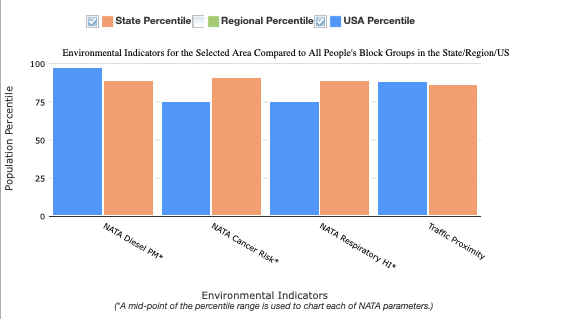
Upon examining the environmental indicators in this map it is clear that there is an air pollution issue that is affecting the health of the people that live here. In the NATA Diesel PM category, which calculates how much diesel particulate matter there is in the air, this area ranks 89th percentile in the state and 95-100th percentile in the country.40 A possible explanation for such a high ranking can be found when observing the traffic proximity on the chart, which shows that this area on the map is 86th percentile in the state and 88th percentile in the country. Clearly, air pollution is an issue here and is caused by this traffic, making it land on one of the highest percentiles for both of these categories. This does not take into account any additional traffic that may be caused now or in the future by American Dream, this is already a burden that is affecting this area that will be worsened by adding 100,000 more cars onto the road.
In this same chart, health effects that can be attributed to NATA Diesel PM and traffic proximity can be seen. Specifically, in NATA Cancer Risk and NATA Respiratory Hazard Index. The NATA cancer risk shows the “lifetime cancer risk from inhalation of air toxics” and the population in the map fell in the 91st percentile in the state and 70-80th percentile in the country.41 Similarly, for the NATA Respiratory Hazard Index which is the “ratio of exposure concentration to health-based reference concentration” this population came out to be 89th percentile and 70-80th percentile.42 This finding shows how there is a correlation between the traffic, the PM released by the cars in that traffic, and the deteriorating health of the people on this map. Now let’s get to see some information about the people in the Meadowlands.
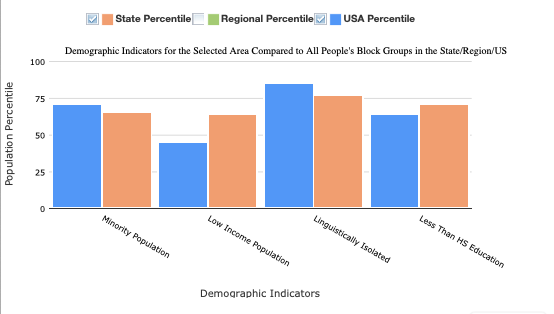
The demographic indicators in this map are able to tell us about the people that reside here and whether they may have any characteristics or challenges that may make them susceptible to environmental injustice. The first indicator is understanding the percentage of the minority population, here 56% of the population is minority and it ranks 65th percentile and 71st percentile in the country. The population isn’t overwhelmingly minority, but the percentage is relatively high when compared to areas of the rest of the state. The next indicator is the low- income population, which makes up 27% of the population on this map ranking 64th in the state and 45th percentile in the country. This means that almost 1 in 5 people included in this map are low income, and much like the minority category compared to the state it is a high number. The fact that the communities surrounding American Dream are composed of working class, ethnic minorities go in line with the environmental justice theory of race and class being indicators for toxic waste sites.43 These two pieces of data are incredibly important through the lens of environmental justice because they coincide with the theory that class and race are the two most working class, people of color.44 This is also true for the last two indicators observed for this site.
The two final indicators observed in the environmental justice analysis of the American Dream site are linguistically isolated and education level indicators. According to EJScreen, the linguistically isolated population in this area, which either don’t speak English or don’t speak it very well, makes up 11% of the total population.45 This high percentage means that this indicator ranks in the 77th percentile in the state and 85th percentile in the country and is the highest overall when compared to the state and country percentiles. This is an important factor when discussing environmental justice because a linguistically isolated population may not be able to advocate for themselves or keep themselves informed in the same way english speakers can.46 The last indicator is the population that has less than a high school education, and roughly 14% of the total population falls in this category making it 71st percentile in the state and 64th in the country. This is another high percentage and high percentile result that is valuable in the environmental justice discourse of this site because the lower education level also tends to point to a working class background. Both of these factors tend to correlate with a toxic site in the area.47
Both the environmental and demographic data is alarming in nature, because of all of the health risks and environmental hazards are currently present without even taking into account the pollution that will be brought on by American Dream. Moreover, understanding it is still important because it showcases the ways in which this community is affected by environmental hazards, and it begins to tell a story as to why these issues are occurring. Each environmental indicator came out in an extremely high percentile and it shows that the pollutants in this area have a hand in or are causing the health hazards. This is important to emphasize because the current environmental and health issues have not even been exacerbated yet by the traffic and pollution that American Dream will cause.
This is important when looking at the demographic indicators under the lens of environmental justice, because there is a link between minority, working class communities “with weak social, economic, and political capital” and the amount of environmental hazards in their communities.48 This can be considered to be true in the case of this site where a large portion of the population is minority and low income, but more telling is that 10% of the population is linguistically isolated. All of the results from these demographic and environmental indicators of this site go hand in hand with the theory of the path of least resistance. This theory argues that industries would purposely go to communities of color, that were low income, or even had low educational levels because they would not be able to fight back like other communities that were white, wealthy, and well-connected.49 This specific indicator is a good example of that, because this large portion of the population may not be able to advocate for themselves or does not have the same sort of social or political capital to enact change as easily as everyone else.

